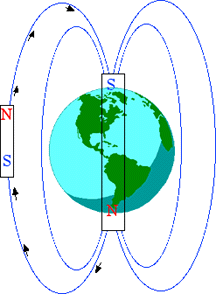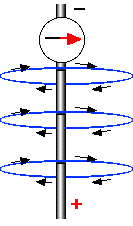- Magnets are surrounded by magnetic fields, the area where magnetic forces are in effect.
- Magnetic fields are three-dimensional, not flat as depicted by most graphics.
- Magnetic field strength is greatest near the poles of a magnet.
Invisible lines of magnetic force are closest together where the magnetic flux is the greatest
Magnetic force lines are imaginary, but help to understand the nature of a magnetic field. Refer to the diagram on page 495 of your text.
Magnetic force lines are continuous, having no beginning and no end. They are directional, however. The direction is from the North pole to the South pole of the magnet.
A magnet, either permanent or induced, will align itself in a magnetic field such that magnetic field lines enter the South end of the magnet, and exit the North end, as shown below.

This is why a compass, whose needle is a small permanent magnet, will always point to the North Pole of the Earth.
- Note that the "North Pole" is so termed because the "North" end of a compass points in that direction, not because there is a North magnetic pole up there!
- This issue can become confusing if you don't pay attention.
- The magnetic field near the Earth is from a combination of three sources:
- 97 - 99 % Main Field (From electric currents in the Outer Core)
- 1 - 2 % Crustal Field (From magnetized rock in the Crust)
- 1 - 2 % External Field (From ionized particles above the Earth)
- The Main Field is near dipolar and varies in strength from approximately 30,000 nT near the equator to 60,000 nT at the poles. Its secular variation or amount of change is about 1% per year. The north and south pole undergo a reversal (change in direction) every 200,000-500,000 years. (The last time was about 780,00 years ago). Kenneth Hoffman of Cal Poly, San Luis Obispo states that the geomagnetic field has weakend over the past 2000 years at such a rate that there could be another reversal within the next 2000 years!
- The External Field varies on time scales of seconds to days, primarily due to solar interactions. These fields result from current systems and range in intensity from fractions of a nT to thousands of nT
- Further, the North geographic pole, one end of the axis about which the Earth rotates, is not in the same location as the geomagnetic pole. The geomagnetic poles' locations are difficult to describe for many reasons. For one thing, the geomagnetic poles are probably actually a collection of several poles. Furthermore, the locations of the principal poles may move tens to hundreds of kilometers because of daily variations in the field and magnetic storms. For more information on geomagnetism, check the National Geophysical Data Center's FAQ page here, or additional information page here.
- The magnetic polarity of the Earth has reversed itself numerous times, as is evidenced by the paleomagnetic discoveries made on the sea floor this centrury.
- Click here to view a quicktime movie of a 3-dimensional magnetic field. This movie is about 2 MB, so allow time for downloading.
An electric current will induce a magnetic field around itself. The shape of this field is such that the lines of magnetic force would form circles in flat planes perpendicular to the current. A compass placed on top of the conductor would point as shown.

What direction would the compass needle point if it were placed below the conductor? You will experiment with this in lab.
Study the first right-hand rule to determine the direction of the magnetic field when the direction of current is known.
Current is defined as the flow of charge down a wire every second.
I = q/t
By multipling both the top and bottom of the equation by the velocity down the length of wire (L), we arrive at the equation:
I = qv/L
If we then substitute this in to our F=BIL equation, we arrive at
F = B(qv/L)L
By cancelling out the length of the wire, we arrive at our final equation of describing the force on a moving charged particle in a magnetic field.
F = Bqv
Where :
F = the magnetic force in Newtons (N)
B = the magnetic field strength in Teslas (T)
q = the charge of a particle in Coulombs (C)
v = the velocity of a particle (m/s)
Similar to our former right hand rule, the direction of the force will be perpendicular to both the magnetic field direction and the direction of velocity.
Labs: magnetic fields, tangent galvanometer
Video: Understanding Magnetism (45 min.)
Quicktime Movies:
3-dimensional field (2 mb)
Magnetic field near a current (31 mb)
Magnetic force on a current (32 mb)
Tangent Galvanometer (40 mb)
|

